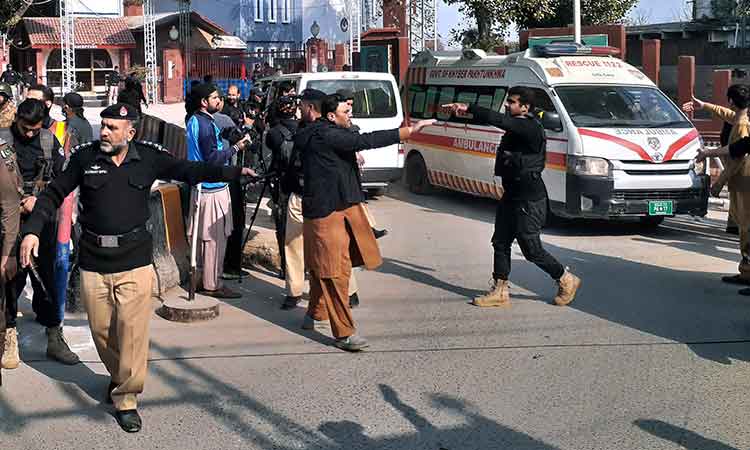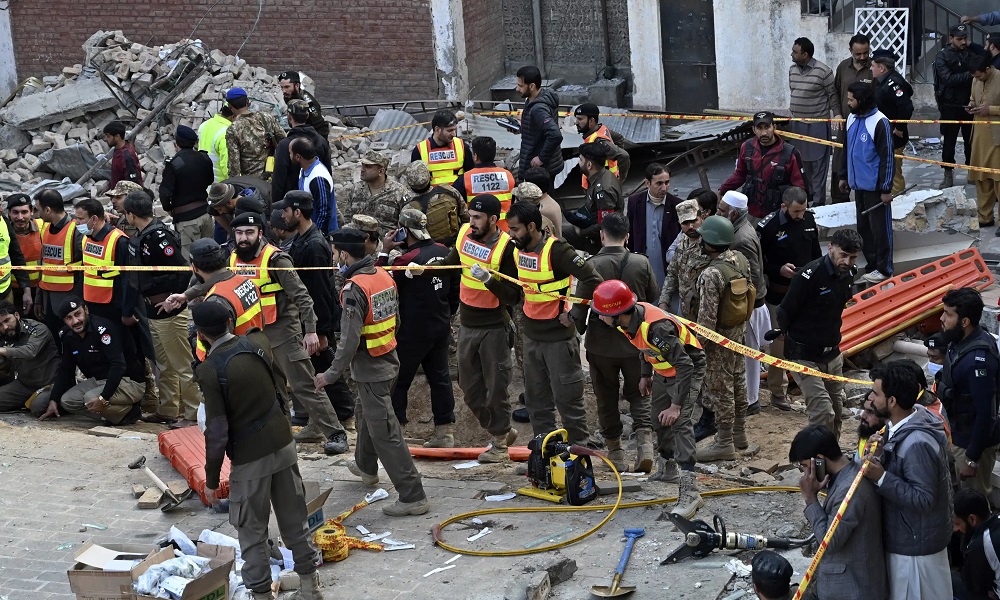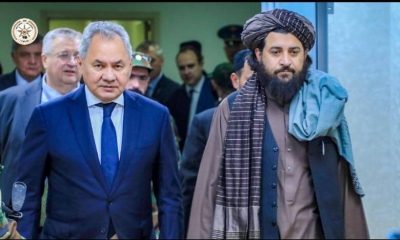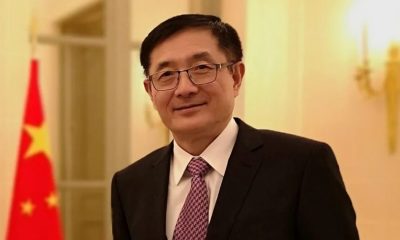Worshipers in a mosque in the high-security zone in Pakistan’s northwestern Peshawar city stained with blood on Monday after a Taliban suicide bomber blew himself up among them during afternoon prayers.
46 people were killed and nearly 150 others, among them police officers, were wounded in the bombing that was claimed by the Pakistani Taliban.
The blast occurred inside the mosque in the Police Lines area around 1.40 pm when worshippers were offering the (afternoon) prayers. Pakistani authorities said that the bomber was present in the front row and blew himself up.
46 people have died so far, according to Lady Reading Hospital, but the Peshawar Police has released a list of 38 victims. It has been also confirmed that most of the injured people were policemen.
Pakistan’s PM and army chief visit Lady Reading Hospital
Soon after the deadly bombing, the country’s civilian and military brass visited Peshawar and went to Lady Reading Hospital. Prime Minister Shehbaz Sharif was accompanied by the Army Chief Lt Gen. Asim Munir and the federal ministers, where they met the survivors under treatment in the hospital. The MP will also hold an emergency meeting and the related officials will present the root cause of the incident.
Sharif before leaving Islamabad to Peshawar has called on his party workers to donate blood to the wounded people and immediately reached Lady Reading Hospital and “contribute to saving precious human lives.”
TTP and revenge attack
The Tehreek-e-Taliban Pakistan (TTP) claimed responsibility for the attack. The group is popular for its anti-Pakistani attacks as it carried out a number of suicide attacks in the past that targeted security personnel.
A brother of the slain commander of the TTP Umar Khalid Khurasani claimed that the suicide attack was part of the revenge attack for his brother who was killed last August in Afghanistan.
Khalid Khorasani and three other top militant leaders were killed in a mysterious blast in eastern Afghanistan’s Paktika province. A vehicle carrying senior commanders of the militant group, including Khorasani, was targeted with a mysterious explosive device as they were traveling in the Birmal district of the province for a meeting.

Police officers clear the way for ambulances leaving after carrying wounding people from bomb explosion site, at the main entry gate of police offices, in Peshawar, Pakistan, on Monday. AP
All aboard the vehicle, also carrying other TTP commanders such as Abdul Wali Mohmand, Mufti Hassan, and Hafiz Dawlat Khan, were killed in the explosion.
Meanwhile, the TTP had threatened to carry out a series of terror attacks after ending ceasefire with the Pakistani government last year. Sarbakaf Mohmand, a commander for the Pakistani Taliban, claimed the responsibility for the attacking in a tweet post.
It was not clear how the bomber was able to enter the mosque but over 300 worshippers were praying at the time of bombing. Many of them were wounded after the roof came down.
The bomber entered the highly secured mosque
Monday’s attack was the deadliest in the start of 2023 where last year was a bloody one in which TTP claimed responsibility for a number of attacks that took the lives of civilians and security personnel.
The big question is how the bomber was able to enter the highly secured mosque inside police lines where four layers of security were in place to enter the mosque.
Superintendent of Police (Investigation), Peshawar, Shazad Kaukab in a briefing to media said that the blast occurred when he just entered the mosque to offer prayers.
Kaukab’s office is very close to the mosque and he said that he was lucky to survive the attack.
Local newspaper (Dawn) reported that a number of people are still stuck under the rubble and the rescue team has been scrambling to pull them out.
Between 300 to 400 police officials were present in the area at the time of the blast, the Capital City Police Officer (CCPO) Peshawar Muhammad Ijaz Khan said according to the newspaper.
Khan told the media that “it is apparent that a security lapse occurred.
Mosque bombing strongly condemned
Prime Minister Shehbaz Sharif has strongly condemned the attack, saying that “terrorists want to create fear by targeting those who perform the duty of defending Pakistan.” He said that the Pakistani nation is standing united against the menace of terrorism.
The country’s Foreign Minister Bilawal Bhutto Zardari also condemned the attack, saying “terrorist incidents before the local and general elections were meaningful”.
Khyber Pakhtunkhwa Governor Haji Ghulam Ali also condemned the blast and called on the people to approach the hospital to donate blood for the injured individuals.
Some sources in the hospital said that around 13 of those injured were in a critical condition.
It has been reported that security has been beefed up in other major cities, including Islamabad, after Peshawar bombing.
Former Prime Minister Imran Khan and Caretaker Chief Minister Azam Khan condemned the attack and offered condolences to the bereaved families.
“My prayers and condolences go to the victims’ families. It is imperative we improve our intelligence gathering and properly equip our police forces to combat the growing threat of terrorism,” Khan tweeted.
Pakistani celebrities also come out to condemn the attack on social media, sending condolences and prayers to the victims and their families.
“Peshawarblast – Tragic and heartbreaking … not sure what else to say. Being a Pakistani now just feels like an endless wait for things to get better while they get worse. May God have mercy on the souls of the departed and may God give patience to the families,” Actor Hamza Ali Abbai said in a tweet.
Actor Saba Qamar sent condolences to the victims’ families.
Cricketer Naseem Shah also condemned the attack stating, “May Allah bring back the peace we as a nation deserve!”
Last year, a similar attack inside a Shia mosque also took the lives of at least 63 people and wounded dozens more.
In 2014, the Pakistani Taliban stormed the Army Public School (APS) in the northwestern city of Peshawar, killing at least 150 people, including 131 students.
Dealing with terrorism requires sufficient consensus
Former Afghan President Ashraf Ghani also condemned the terrorist attack in Peshawar and expressed his deepest sympathies with the families of the martyrs and prayed for the speedy recovery of the victims. “The Afghan people understand and share the grief as does every Muslim and every human being in the world,” Ghani said in a series of tweets.
Overcoming the threat of terrorism requires a sufficient consensus within the Muslim world in general and within our region in particular to identify and address its underlying causes, he added.
He also sees an opportunity that Pakistan has to offer “a novel set of solutions to a threat that has been hitherto only dealt with through violent military.”
“We the Afghan people who have suffered senselessly from international and regional discord and division are ready and willing to contribute to such a constructive endeavor,” he added.
Mohsin Dawar, Pakistan’s member national assembly also retweeted Ghani’s tweet.
“Peshawar bleeds again with the suicide attack at the mosque in Police Lines. There is a war underway in Pakhtunkhwa,” Dawar said in a separate tweet.
He furthered, “Pashtuns continue to be killed. The state refuses to abandon its flawed Afghan policy. Those who continue to support the Taliban need to be held accountable.”

 OPINION1 week ago
OPINION1 week ago
 DIPLOMACY1 week ago
DIPLOMACY1 week ago
 ASIA1 week ago
ASIA1 week ago
 DIPLOMACY4 days ago
DIPLOMACY4 days ago
 DIPLOMACY3 days ago
DIPLOMACY3 days ago
 AMERICA2 weeks ago
AMERICA2 weeks ago
 MIDDLE EAST1 week ago
MIDDLE EAST1 week ago
 AMERICA2 weeks ago
AMERICA2 weeks ago






















